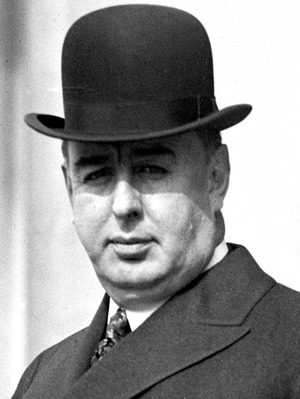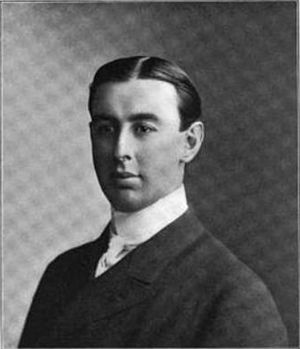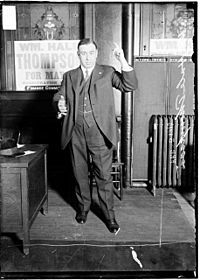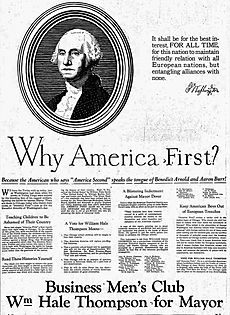William Hale Thompson facts for kids
Quick facts for kids
William Hale Thompson
|
|
|---|---|
 |
|
| 41st & 43rd Mayor of Chicago | |
| In office April 18, 1927 – April 9, 1931 |
|
| Preceded by | William Emmett Dever |
| Succeeded by | Anton Cermak |
| In office April 26, 1915 – April 16, 1923 |
|
| Preceded by | Carter Harrison, Jr. |
| Succeeded by | William Emmett Dever |
| Member of the Cook County Board of Commissioners | |
| In office 1902–1904 |
|
| Chicago Alderman from the 2nd Ward | |
| In office 1900–1902 |
|
| Personal details | |
| Born | May 14, 1869 Boston, Massachusetts, U.S. |
| Died | March 19, 1944 (aged 74) Chicago, Illinois, U.S. |
| Political party | Republican |
| Spouse |
Mary Walker Wyse
(m. 1901) |
| Signature | |
William Hale Thompson (born May 14, 1869 – died March 19, 1944) was an American politician. He served as the mayor of Chicago two times. His first time was from 1915 to 1923. He was mayor again from 1927 to 1931.
People often called him "Big Bill". He was the last Republican to be mayor of Chicago. Some historians say he was one of the mayors who had the most problems with ethics. This was mainly because he was connected to Al Capone and other organized crime figures. But others saw him as a clever politician. They noted how well he used publicity in his campaigns. He was known for his big, exciting campaigns. He also used very direct language. These things, along with his tall height, gave him his famous nickname.
After he died, people found two safe-deposit boxes in his name. They held over $1.8 million. This discovery made his popularity drop.
Contents
Early Life and Nickname
Thompson was born in Boston, Massachusetts. This was on May 14, 1869. His family moved to Chicago when he was only nine days old. Even though he was born in Boston, he had strong ties to Chicago. His father, William Hale Thompson Sr., was a well-known businessman. He also served in the military. His grandfather, Stephen F. Gale, was the first chief of the Chicago Fire Department. He helped create the city's rules in 1837. Many people saw him as a "Chicago pioneer."
Thompson went to Chicago Public Schools. He also took extra classes at other schools. He was supposed to go to Yale University. But instead, he moved to Wyoming when he was 14. There, he became a cowboy and owned cattle. He also traveled across Europe. Later, he worked on ranches in Texas and New Mexico. These experiences influenced his campaigns. He often wore a sombrero, which became a symbol for him. By age 21, he had saved $30,000.
In 1892, he came back to Chicago after his father passed away. He returned to manage his family's property. Soon after, he joined sports clubs. He became a director and captain for water polo and football teams. He was six feet tall and very athletic. This led to his nickname, "Big Bill." The name stayed with him throughout his political career.
Starting His Political Career
Thompson worked on the Real Estate Board of Chicago. In 1900, he won an election to become an alderman. An alderman is a member of the Chicago City Council. He represented the 2nd Ward, which was his home area. Two years later, he became a member of the Cook County Board of Commissioners. He served from 1902 to 1904.
During this time, Thompson formed a political team with Frederick Lundin. Lundin was a Republican city clerk. People said they worked very well together. Thompson was outgoing and charming. He had a strong public presence. Lundin was smart with political ideas. Together, they were a powerful team in Chicago politics.
First Time as Mayor (1915–1923)
Becoming Mayor in 1915
In 1915, Thompson was elected as the 41st Mayor of Chicago. He won against several other candidates. He took office on April 26, 1915. In his first speech as mayor, Thompson shared his big goals. He wanted Chicago to become "the greatest in the world." He also promised that his actions would not be influenced by corruption.
He focused on public safety and improving public transportation. He also wanted to lower gas prices. Thompson believed Chicago should have more local control over its laws. He also wanted to help Chicago's businesses grow. His efforts to improve and expand Chicago's streets earned him another nickname: "Big Bill the Builder." During his time, he oversaw the completion of the Michigan Avenue Bridge. He also helped widen Twelfth Street and Ogden Avenue.
Thompson wanted Chicago to grow politically and economically. He felt Chicago should make its own laws. He believed this should happen without outside interference.
Dealing with Challenges
Early in his time as mayor, Thompson faced a big disaster. The Eastland boat capsized in July 1915. Many people died. Thompson quickly returned to Chicago to help. He set up a relief fund and ordered an investigation. He wanted to find out why the tragedy happened.
In 1915, a group of women asked Thompson to appoint a qualified woman. They wanted her to lead the city's new public welfare office. Thompson did appoint a woman, Louise Osborn Rowe. But she was a political supporter, not someone with a welfare background. Within a year, she was accused of misusing public money. She had to resign in 1916.
Thompson also gained attention for his neutral stance on World War I. He did not support the war. He allowed anti-war meetings to happen in Chicago. This led some to call Chicago "the sixth German city of the world." It also earned him the nickname "Kaiser" Bill Thompson. He tried to appeal to German and Irish people in the city. He did this by being anti-British. These actions later hurt his chances in his 1918 U.S. Senate campaign. In 1916, he became a member of the Republican National Committee.
Second Term as Mayor
Thompson was reelected mayor in 1919. He won against Robert Sweitzer again. He claimed to be a champion for ordinary people. He spoke out against utility companies and wealthy people who avoided taxes. He tried to keep streetcar fares low. He even sued the Chicago "L" when it tried to raise fares. However, the fare eventually went up to seven cents.
In his second speech as mayor, Thompson spoke about expanding Chicago. He said, "Chicago is greater than some nations." He wanted to extend and widen streets. He also planned for new post offices, playgrounds, and bridges. Thompson also proposed a zoning law. This law would create separate areas for businesses, industries, and homes. He also promised to improve telephone services and expand the Chicago Police Department.
Early in his second term, the city faced the Chicago race riot of 1919. Thompson did not run for reelection in 1923. William Emmett Dever became the next mayor. Thompson left office on April 16, 1923.
Chairman of the Illinois Waterways Commission
After leaving the mayor's office, Thompson became chairman of the Illinois Waterways Commission. He used this role to stay in the public eye. He promoted a project to build a waterway. This waterway would connect the Great Lakes to the Gulf of Mexico. To get attention, Thompson went on a "scientific" trip in 1924. He went to the South Seas to find a tree-climbing fish. He even bet $25,000 on his success, but no one took the bet.
Second Time as Mayor (1927–1931)
Thompson ran for mayor again in 1927. This was during a time of conflict between different groups in the city. He wanted to defeat the current mayor, William Dever. Thompson was always a showman in his campaigns. He even held a debate with two live rats. He used the rats to represent his opponents.
He promised to clean up Chicago. But he often focused on reformers, calling them the real problem. Thompson also claimed that King George V of the United Kingdom was America's biggest enemy. He told his supporters, many of whom were Irish, that he would punch the king if they ever met. After he won, his boat, known as the Fish Fans Club, was filled with supporters. So many people were on board that the boat actually sank!
Thompson wanted to remove Superintendent William McAndrew from the public school system. He wanted to teach what he called the "true history of George Washington." He also wanted to remove "propaganda" from schools. In August 1927, the Chicago Board of Education charged McAndrew with not following orders. They also accused him of not being patriotic. They suspended him. The board found McAndrew guilty, but a court later overturned this decision.
Al Capone's support was very important for Thompson to become mayor again. During Thompson's second term, there was a violent election called the "Pineapple Primary" in 1928. This name came from the hand grenades thrown at voting places. Another famous event during his term was the St. Valentine's Day Massacre. These events showed the serious problems with organized crime in Chicago.
Thompson lost the 1931 mayoral election to Anton Cermak. Cermak was an immigrant from Bohemia. Thompson tried to make fun of Cermak's name and background. He used unkind words like:
I won't take a back seat to that Bohunk, Chairmock, Chermack or whatever his name is.
Tony, Tony, where's your pushcart at?
Can you picture a World's Fair mayor with a name like that?
Cermak responded, "He doesn't like my name...It's true I didn't come over on the Mayflower, but I came over as soon as I could." Many people in Chicago, especially immigrants, understood this feeling. So, Thompson's insults did not work. Thompson left office on April 9, 1931.
Later Political Attempts
In 1936, Thompson ran for governor of Illinois. He ran as a "Union Progressive" candidate. He only received three percent of the votes. In 1939, Thompson ran for mayor of Chicago again. But he was easily defeated in the Republican primary election. He lost by a large margin.
Personal Life and Death
In 1901, Thompson married Mary "Maysie" Walker Wyse. She worked in his father's office. They never had children.
William Hale Thompson died on March 19, 1944. He was 74 years old. He passed away at the Renaissance Blackstone Hotel in Chicago. He was buried in Oak Woods Cemetery.
Even though many people liked Thompson, few attended his funeral. One reporter noted that there were no flowers or ferns. After Thompson's death, two safe-deposit boxes were found in his name. They contained almost $1.84 million in cash. This money would be worth much more today. After taxes were paid, his wife, Maysie Thompson, lived off the rest until she died in 1958.
How Historians See Him
Historians often describe Thompson as one of the mayors with the most ethical problems. This is mainly because of his connections to organized crime figures like Al Capone. However, others recognize that his political methods were effective. They also note his strong focus on publicity in his campaigns. They called him a "Political Chameleon" and a powerful political force.
Time magazine said in 1931 that Thompson deserved "chief credit for creating 20th Century Politics Chicago Style." In 1993, a survey of experts ranked Thompson as the worst American big-city mayor between 1820 and 1993.
See also
 In Spanish: William Hale Thompson para niños
In Spanish: William Hale Thompson para niños





